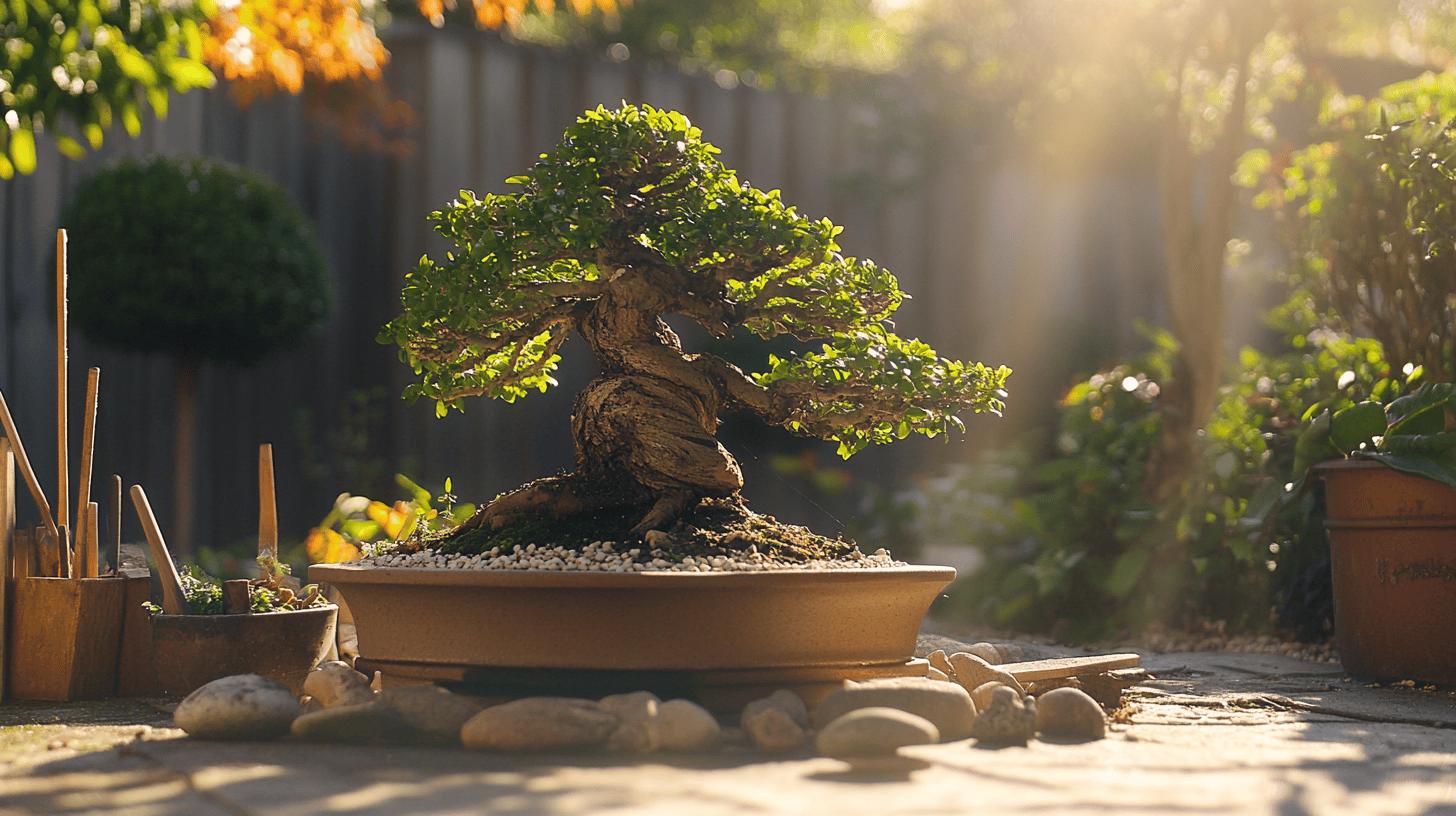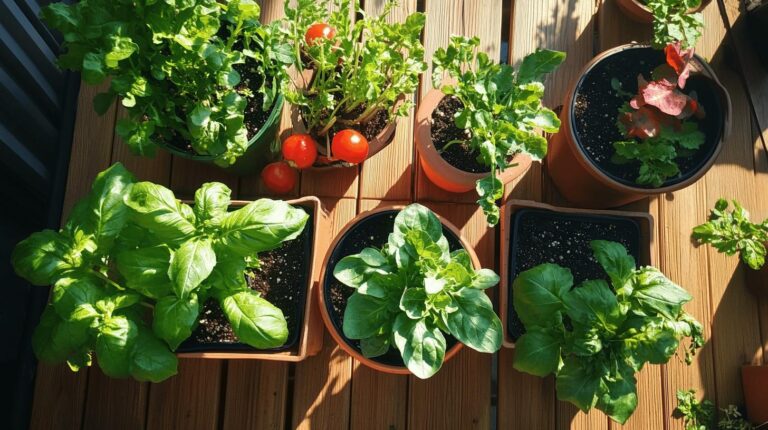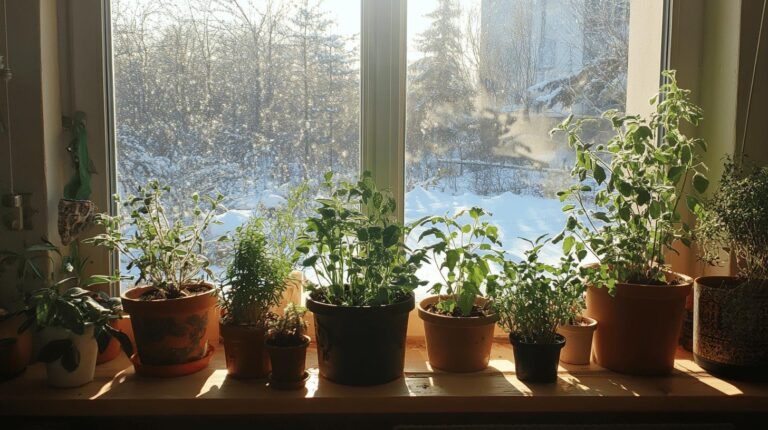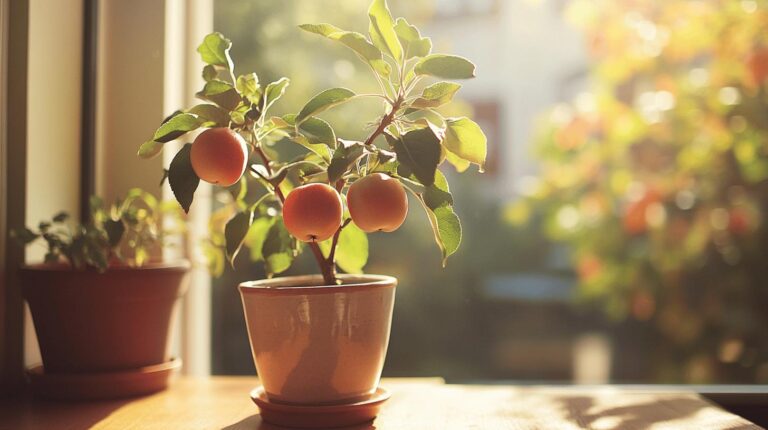Backyard Bonsai: How to Cultivate a Peaceful Garden Oasis
Have you ever considered that the secrets to serenity and beauty might be growing right in your backyard? Bonsai gardening is not just about cultivating tiny trees; it’s about bringing a sense of peace and nature’s elegance into your world. With roots stretching back nearly a thousand years in Japanese culture, bonsai has captured imaginations worldwide. As we dive into the art of backyard bonsai gardening, I’ll guide you on how those miniature marvels can transform your outdoor space into a sanctuary of tranquility and charm. Let’s explore the path to making your very own peaceful retreat.
Understanding Backyard Bonsai Gardening
Bonsai gardening has a rich history that dates back nearly a thousand years, deeply rooted in Japanese culture. Initially embraced by the elite, bonsai was a way to capture the essence of nature in miniature form. This art form represents a blend of patience, care, and appreciation for natural beauty. Through cultural exchanges, bonsai has made its way into the Western world, where it has been embraced for its aesthetic appeal and the tranquility it brings. The practice of bonsai is not merely about cultivating trees but also about promoting peace and prosperity, making it a cherished tradition across different cultures.
In recent years, the allure of bonsai gardening has grown in Western backyards, fueled by its ability to transform outdoor spaces into serene retreats. Bonsai’s modern appeal lies in its ability to connect us with nature, offering a therapeutic escape from the hustle and bustle of daily life. The art of shaping and nurturing these miniature trees provides a creative outlet, allowing individuals to express their artistic vision while finding mindfulness in the process. Whether as a focal point or an integrated part of a garden, bonsai adds a unique charm to backyard spaces.
- Provides a soothing and tranquil environment
- Encourages mindfulness and patience
- Enhances the aesthetic appeal of outdoor areas
- Offers a creative and artistic outlet
- Connects individuals with nature and tradition
By integrating bonsai into backyard spaces, one can cultivate not only beautiful landscapes but also a sense of peace and harmony.
Steps to Create a Bonsai Garden in Your Backyard
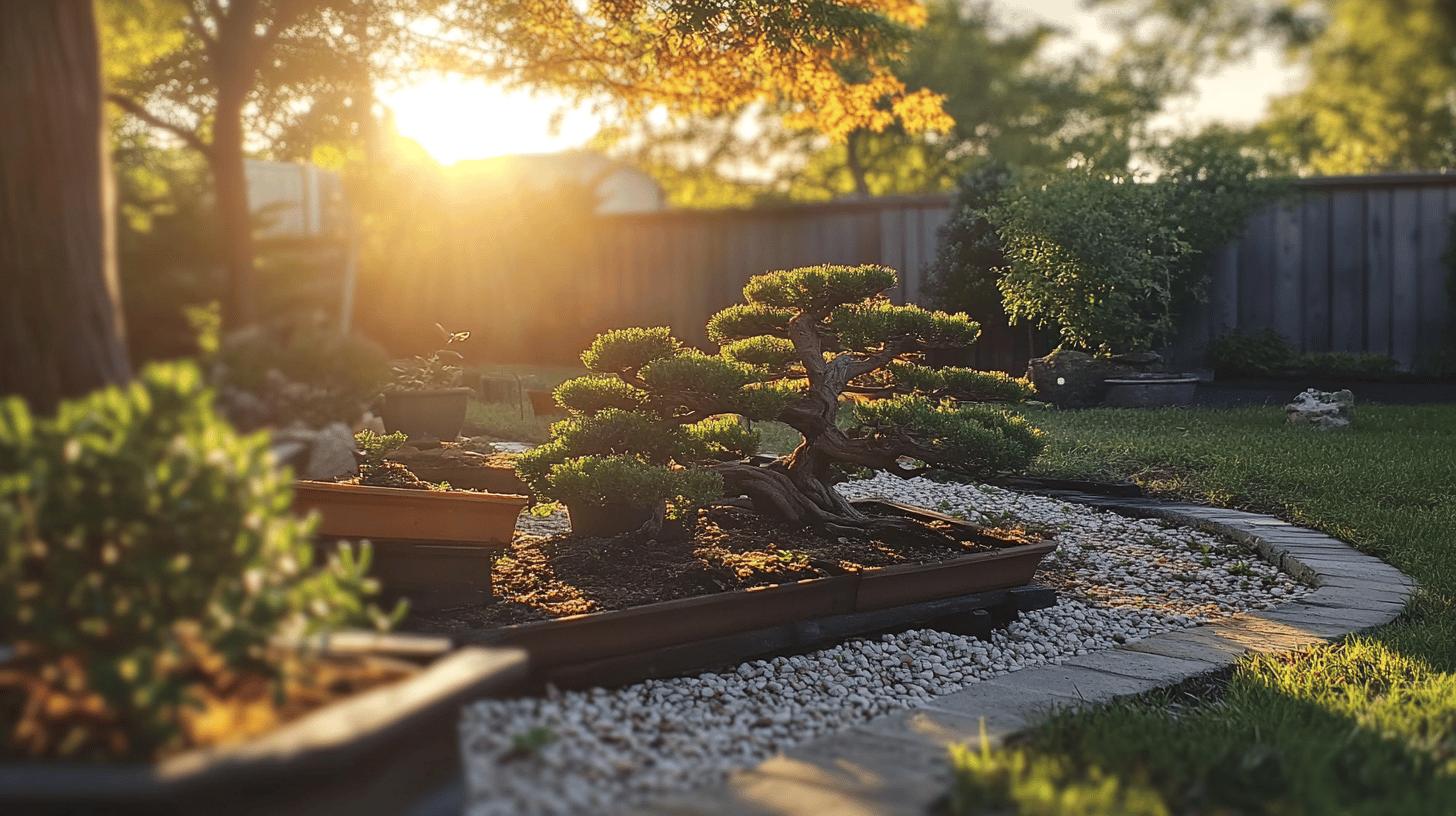
Creating a bonsai garden is an engaging process, requiring careful planning to ensure a harmonious and sustainable space. From selecting the right trees to ongoing care, each step builds towards a tranquil retreat that reflects your artistic vision and commitment to nature.
Landscaping
The first step is to visualize your garden’s layout. Consider the space available, sunlight exposure, and how you want to incorporate bonsai into your existing garden. Think about pathways, water features, and seating areas that might enhance the overall design. A well-thought-out plan will guide you through the subsequent steps, ensuring your garden is both functional and beautiful.
Selecting Bonsai Trees
Choosing the right bonsai species is crucial. Consider factors such as your local climate, the amount of sunlight your garden receives, and the level of care each tree requires. Beginners might start with hardier species like Juniper or Japanese Maple, which are more forgiving and require less intensive care.
Acquiring Materials
Gather essential tools and materials to set up your bonsai garden. You’ll need pruning shears, wire, specialized pots, and a suitable soil mix. A bonsai starter kit can be a great way to acquire these items, providing everything you need to begin your journey.
Laying the Base and Planting
Setting the foundation involves creating a stable base for your bonsai. Use materials like exposed aggregate concrete for a durable and attractive surface. When planting, ensure your trees have the right soil blend to promote healthy growth, typically a mix of akadama, pumice, and organic compost.
Ongoing Maintenance
A bonsai garden requires regular care to thrive. For those new to the world of gardening, a beginner’s guide to garden maintenance can be an invaluable resource. Just as bonsai trees need specific attention, understanding the broader principles of garden upkeep will ensure that your entire outdoor space flourishes. Whether it’s learning the basics of soil care, watering schedules, or pest control, having a solid foundation in garden maintenance will enhance your bonsai gardening experience. By integrating these practices, you can create a harmonious and sustainable environment that supports both your bonsai and the surrounding garden. Establish a maintenance schedule that includes watering based on the tree’s needs, pruning to maintain shape, and monitoring for pests. Seasonal adjustments, like protecting trees from extreme weather, are vital for long-term sustainability and beauty.
Choosing the Right Bonsai Species for Your Backyard
Selecting the perfect bonsai species for your backyard involves considering several key factors, such as your local climate, the amount of sunlight your garden receives, and the amount of time and care you’re willing to invest. Different species have varying requirements, and choosing one that aligns with your environment and lifestyle will make the process more enjoyable and sustainable. For instance, some species thrive in full sunlight, while others may need a bit of shade during the hottest part of the day.
- Juniper: Hardy and forgiving, ideal for those new to bonsai gardening.
- Japanese Maple: Offers stunning seasonal color changes, but requires protection from extreme weather.
- Ficus: Tolerant of low light, making it suitable for indoor and outdoor gardens.
- Chinese Elm: Adaptable with fine branching, perfect for beginners.
- Jade Tree: Thrives in warm climates and requires minimal watering, making it a low-maintenance choice.
Understanding the unique needs of each bonsai species is essential for success. Some trees require specific soil types, while others may need frequent pruning to maintain their shape. By familiarizing yourself with these requirements, you can ensure the health and beauty of your bonsai garden, creating a harmonious environment that reflects both natural beauty and personal expression.
Essential Tools and Materials for Backyard Bonsai Gardening
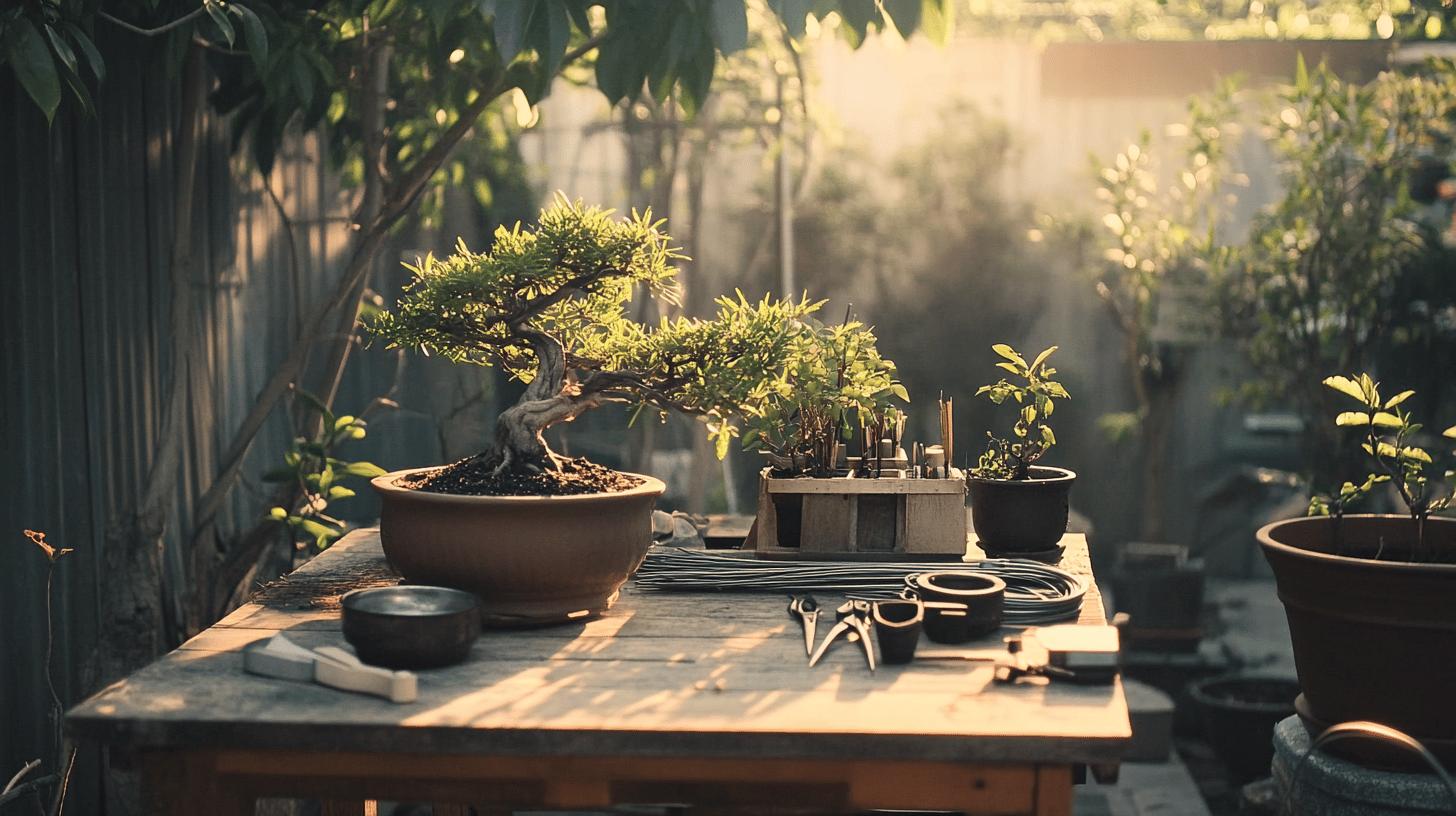
In the world of bonsai gardening, having the right tools is as crucial as the care and patience you dedicate to your miniature trees. The precision and artistry involved in shaping and maintaining bonsai cannot be achieved without proper equipment. Just as a painter needs quality brushes, a bonsai gardener requires specialized tools to nurture their living canvas. From pruning to wiring, every task benefits from having the right instruments at your disposal. A bonsai starter kit can be an excellent investment, providing you with the basics needed to embark on this rewarding journey.
- Pruning Shears: Essential for precise cutting and shaping of branches.
- Concave Cutters: Designed to remove branches without leaving unsightly stubs.
- Bonsai Wire: Used to train and shape branches into desired forms.
- Wire Cutters: Specifically made to handle bonsai wire without damaging the tree.
- Specialized Pots: Crucial for controlling growth and providing stability.
- Soil Mix: A blend like akadama, pumice, and organic compost for optimal drainage.
- Root Rake: Helps in loosening soil and untangling roots during repotting.
Using suitable containers and wiring techniques is fundamental in bonsai gardening. The pots you choose not only impact the aesthetic appeal but also play a vital role in the health of your tree by controlling root space and moisture levels. Proper wiring techniques allow for the graceful shaping of branches, guiding them to grow in harmony with your vision. With the right tools and materials, your backyard bonsai garden can flourish, reflecting both natural beauty and your personal touch.
Bonsai Care: Watering, Pruning, and Soil Requirements
Understanding the basics of bonsai care is crucial for nurturing these miniature trees into healthy, beautiful specimens. Each bonsai species has unique needs, and a one-size-fits-all approach often leads to disappointment. By focusing on species-specific requirements, you can maintain the health and aesthetics of your bonsai garden. This involves not only watering and pruning but also ensuring the right soil conditions for optimal growth. Let’s delve into each of these essential aspects of bonsai care.
Watering Techniques
Effective watering is fundamental in bonsai care. Each tree’s water needs will vary based on its species, size, pot, and environment. A good rule of thumb is to water when the topsoil feels slightly dry to the touch. Overwatering can lead to root rot, while underwatering can stress the tree. Some species favor consistent moisture, while others thrive with a drying period between watering. Observing your bonsai and adjusting your watering routine accordingly will help maintain its vitality.
Pruning Methods
Pruning is both an art and a science in bonsai cultivation. Regular trimming is necessary to maintain the desired shape and promote a healthy structure. There are two main types of pruning: maintenance and structural. Maintenance pruning involves snipping away new shoots to refine the tree’s shape, while structural pruning is more aggressive, focusing on altering the tree’s framework. Both techniques are essential for encouraging new growth and achieving the elegant forms that bonsai are known for.
Soil Requirements
The right soil blend is pivotal for bonsai health. A mixture of akadama, pumice, and organic compost in a 2:1:1 ratio is commonly recommended. This blend ensures good drainage, allowing air to reach the roots while retaining enough moisture and nutrients for the tree. The soil’s composition impacts the tree’s ability to absorb water and nutrients, making it a critical factor in the overall care of your bonsai. Regularly replenishing the soil and repotting the tree every few years will support its long-term growth and vitality.
Designing a Backyard Bonsai Garden for Aesthetic Appeal
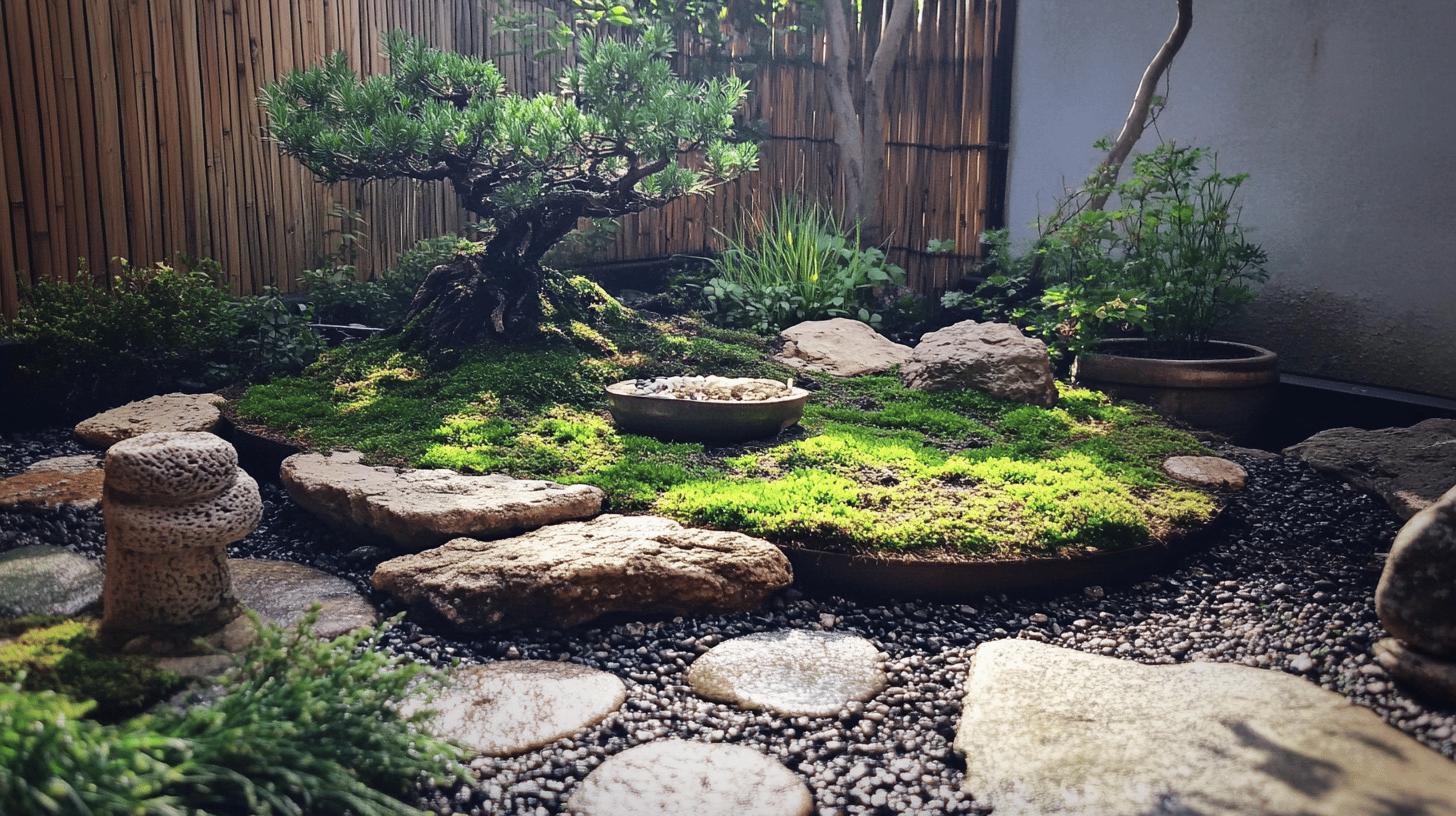
In the world of bonsai gardening, aesthetics play a vital role in transforming a simple arrangement of miniature trees into a captivating and serene retreat. The visual appeal of a bonsai garden is not just about the individual trees; it’s about creating a harmonious setting that reflects balance and tranquility. This involves thoughtful placement, the use of complementary elements, and a keen eye for detail. By incorporating various design elements, a bonsai garden can become a focal point in your backyard, inviting a sense of peace and artistic expression.
- Stones: Use stones to mimic natural landscapes and create a sense of scale and depth.
- Moss: Adds texture and a lush, green carpet effect that complements the trees.
- Miniatures: Incorporate small figurines or structures to enhance the garden’s storytelling aspect.
- Water Features: Introduce small ponds or fountains to bring a calming auditory element.
- Pathways: Design meandering paths using gravel or stepping stones for guided exploration.
- Lighting: Use subtle lighting to highlight key features and create ambiance during evening hours.
Showcasing your bonsai collection effectively can elevate the entire aesthetic of your backyard. Consider using multi-tiered benches to display multiple trees at varying heights, allowing each bonsai to be viewed individually while contributing to the overall garden composition. Vertical gardens or wall-mounted displays offer unique opportunities for small spaces, maximizing visibility and interest. For larger backyards, creating a dedicated bonsai corner with seating areas invites relaxation and contemplation. By thoughtfully arranging your bonsai and incorporating these elements, you can craft a visually stunning and peaceful outdoor sanctuary.
Overcoming Common Challenges in Backyard Bonsai Gardening
Backyard bonsai gardening, while rewarding, comes with its fair share of challenges. Many bonsai enthusiasts encounter issues related to pest infestations, diseases, and environmental stressors that can threaten the health of their miniature trees. Each bonsai species has its own set of needs, making it essential to understand these requirements to ensure healthy growth. Environmental factors like temperature fluctuations, inadequate lighting, and improper watering can also pose significant hurdles. Addressing these challenges requires a combination of knowledge, vigilance, and adaptability.
- Pest Infestations: Common pests such as aphids or spider mites can be controlled through regular inspection and using insecticidal soap or neem oil.
- Root Rot: Caused by overwatering or poor drainage, this can be prevented by using well-draining soil and allowing the soil to dry between watering.
- Fungal Diseases: Powdery mildew or leaf spot can be mitigated by ensuring good air circulation and applying fungicides as needed.
- Nutrient Deficiency: Yellowing leaves may indicate a lack of nutrients; regular feeding with a balanced fertilizer can help.
- Sunburn: Excessive sunlight can scorch leaves, so providing some shade during peak sun hours is beneficial.
Preventive measures and regular monitoring are crucial in maintaining healthy bonsai. By being proactive and observant, gardeners can catch potential problems early and adjust care practices accordingly. Seasonal adjustments, such as moving trees to protect them from extreme weather or adjusting watering routines, are essential in preventing stress and disease. Consistent care and attention not only help overcome common challenges but also enhance the overall vitality and beauty of your bonsai garden.
Integrating Bonsai into Zen Garden Designs
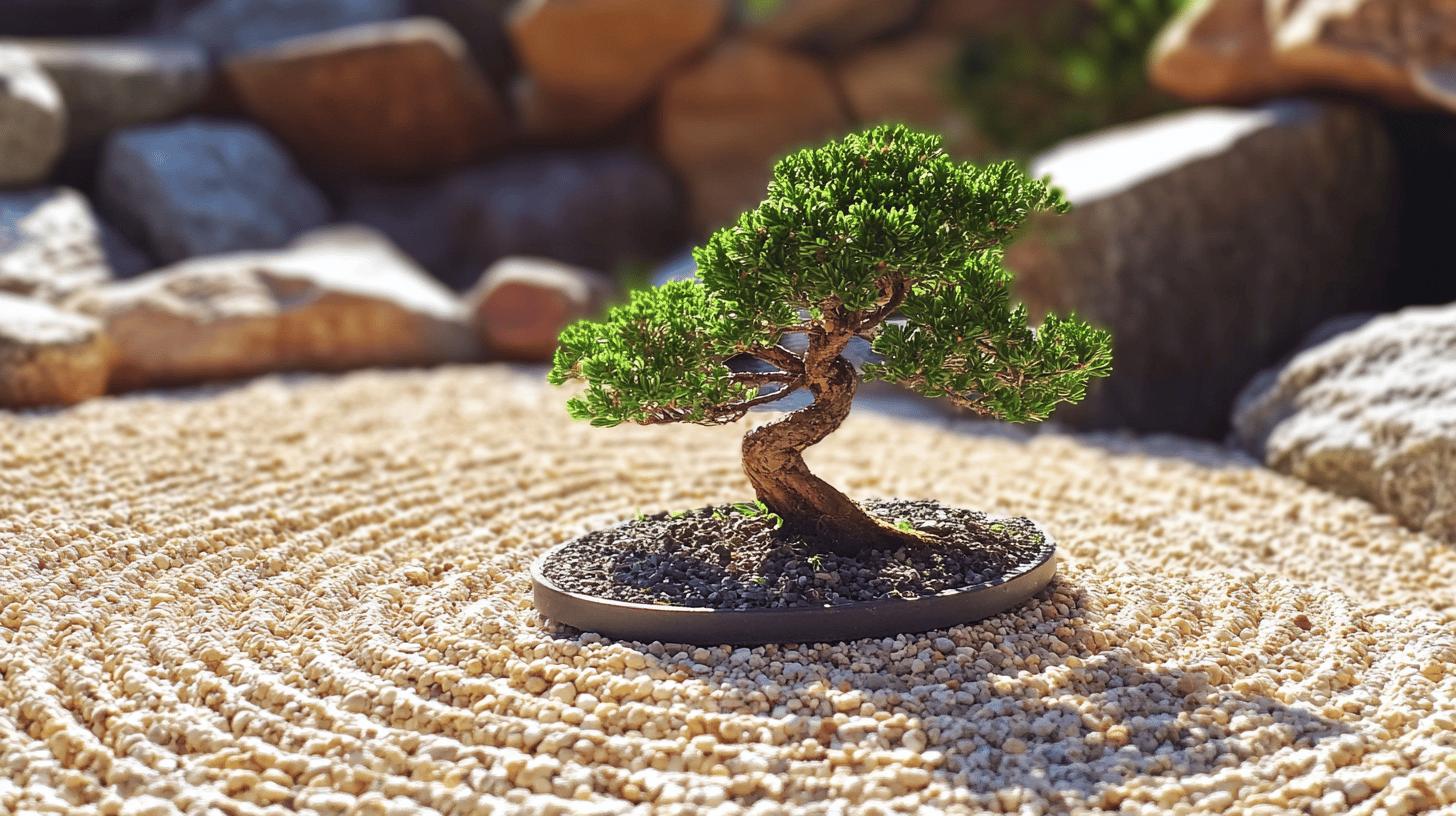
Bonsai and zen gardening share a profound connection, both emphasizing simplicity, mindfulness, and harmony with nature. Bonsai trees, with their meticulously crafted forms, encapsulate the essence of nature in miniature, aligning perfectly with the zen philosophy of balance and tranquility. These elements come together to create serene landscapes that promote peace and prosperity, making bonsai an ideal feature in any zen garden.
Incorporating bonsai into zen garden designs involves thoughtful placement and the use of complementary features. Arrange bonsai trees alongside carefully raked gravel patterns, which symbolize water and flow. Use stones to represent mountains, adding depth and contrast to the scene. The integration of moss can soften the landscape, providing a lush, green backdrop that enhances the bonsai’s natural beauty. These design ideas blend seamlessly, creating a cohesive and meditative environment.
Achieving harmony in a zen garden requires mindful bonsai arrangements, focusing on balance and proportion. Select trees that complement the garden’s overall theme, considering their size, shape, and color. Placing bonsai at varying heights and distances encourages a sense of depth and perspective, inviting contemplation and reflection. Through these thoughtful arrangements, your zen garden can become a sanctuary of peace and tranquility, offering a perfect retreat from the stresses of daily life.
Seasonal Care Practices for Backyard Bonsai
Adapting your bonsai care practices to the changing seasons is crucial to maintaining their health and beauty year-round. Each season presents unique challenges and requirements that need to be addressed to ensure your miniature trees thrive. By tailoring your care routine to accommodate these seasonal variations, you can create an ideal environment for your bonsai, whether they’re indoors or outdoors.
Spring and Summer
During spring and summer, bonsai trees enter their active growth phase and require more frequent watering to support their development. It’s essential to monitor the soil moisture levels closely and water when the top layer feels dry. As temperatures rise, protecting your bonsai from intense sunlight becomes crucial to prevent leaf burn. If outdoors, consider providing some shade during peak sun hours. For indoor bonsai, ensure they receive adequate light while avoiding direct exposure to harsh rays that can stress the trees.
Fall and Winter
In fall and winter, bonsai trees experience a dormancy period, during which their growth slows down significantly. This is a time to reduce watering, allowing the soil to dry out more between sessions, as the trees’ water requirements decrease. Protecting your bonsai from cold temperatures is vital, especially if they’re kept outdoors. Consider moving them to a sheltered location or using mulch to insulate the roots. For indoor bonsai, maintain a stable environment with adequate humidity to prevent stress from dry, heated indoor air. These measures will help your bonsai remain healthy and ready to flourish when spring arrives.
Exploring Bonsai as an Artistic and Therapeutic Hobby
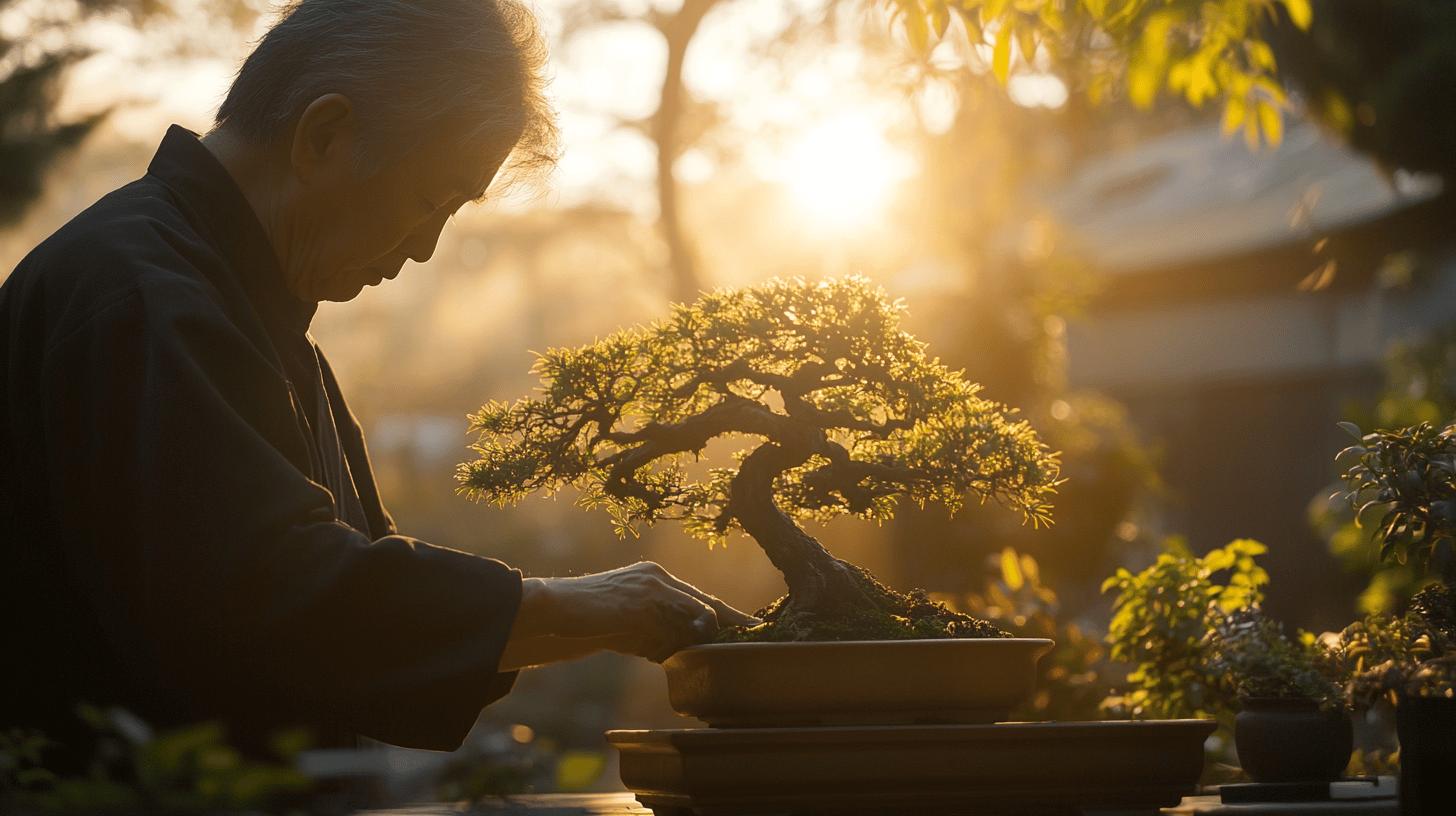
Bonsai gardening beautifully intertwines art and nature, offering endless possibilities for artistic expression. The process of shaping and styling bonsai trees is akin to sculpting, where each snip and wire placement contributes to an evolving masterpiece. By carefully guiding branches and foliage, you create living art that reflects personal vision and creativity. This meticulous craft not only enhances the visual appeal of the bonsai but also mirrors the gardener’s unique style and personality.
Beyond its artistic allure, bonsai gardening serves as a form of mindfulness and stress relief. The focused attention required to nurture bonsai encourages a state of calm and presence, making it a therapeutic escape from daily pressures. As you engage with your miniature trees, the rhythmic tasks of pruning and watering offer a meditative routine, grounding you in the moment and fostering a sense of peace.
The personal fulfillment gained from bonsai gardening is immense. Watching a tree mature from a sapling to a beautifully styled form brings satisfaction and joy. The dedication involved in caring for these miniature landscapes cultivates patience and appreciation for nature’s slow and deliberate processes. As a hobby, bonsai gardening not only beautifies your space but enriches your life with tranquility and creativity.
Final Words
Amid the peaceful world of backyard bonsai gardening, we’ve journeyed through understanding its rich history, explored steps for crafting a garden, and discovered ways to choose the right species.
From tools and techniques to designing and overcoming challenges, bonsai offers a unique blend of artistry and mindfulness.
Integrating bonsai into your zen spaces enhances both aesthetic appeal and personal well-being. As you cultivate your own backyard haven, may you find joy and tranquility with each tiny tree flourishing under your care.
FAQ
Can I grow a Bonsai tree in my backyard?
Growing a bonsai tree in your backyard is possible with the right species selection and care. Choose outdoor-friendly species, ensure proper watering, and protect them from extreme weather.
What is the rule of 3 in bonsai trees?
The rule of 3 in bonsai emphasizes balance: a tree should have a strong trunk, healthy roots, and styled branches. This trio creates visual harmony and structural integrity in the bonsai design.
What is the golden rule of bonsai?
The golden rule of bonsai is patience. Allowing the tree to grow at its natural pace and making gradual changes is crucial for its long-term health and aesthetic.
Is bonsai an expensive hobby?
While bonsai can be costly, it doesn’t have to be. Beginners can start with affordable trees and tools, gradually investing as they gain experience and confidence.
What types of outdoor bonsai trees are suitable?
Outdoor bonsai favorites include Ficus microcarpa, Juniper, Japanese maple, and Weeping fig. Each species offers unique beauty and thrives in different climates and care conditions. Choose based on your local environment and experience level.
What kind of garden is ideal for bonsai?
A bonsai garden should offer indirect sunlight, protection from harsh weather, and space for artistic display. Incorporate elements like stones and moss for aesthetic enhancement.
What are some bonsai display ideas for my backyard?
Consider using multi-tiered shelves, tables with varying heights, or integrating bonsai into rock gardens. These displays create a focal point while supporting different bonsai growth stages.
What should a backyard bonsai gardening kit include?
A complete bonsai gardening kit includes pruning shears, wire, specialized pots, soil mix, and sometimes tree seeds or saplings. Investing in quality tools ensures effective bonsai care and cultivation.
